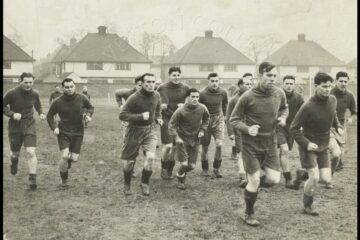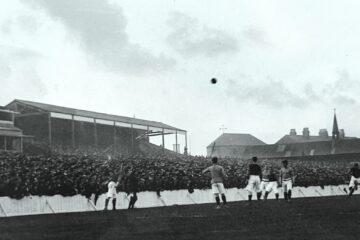[This article was written for the 21 May 2017 Premiership fixture against Arsenal at Goodison Park]
This week’s clash with Arsenal, the 195th in total, will in no way resemble the occasion when the two sides first met 125 years ago (1892), in what is today The Royal Borough of Greenwich. It was the first time that the Anfield club had visited the capital, and their understrength party, which consisted of fifteen players, left Liverpool without their leading goal scorer Fred Geary, who was suddenly recalled to Nottingham because of a family bereavement. Club captain Andrew Hannah, along with Alec Brady, were also absent when the train left Lime Street Railway Station in good time for the party to spend a comfortable Friday evening in London, by attending a show at the Convent Garden Theatre.
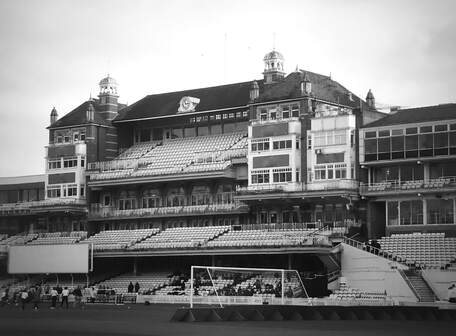
Everton were the current Football League Champions and had been invited to tour London, where a pre-arranged programme of three fixtures awaited them. The opening game was to be at the Oval Cricket Ground (right) against a Corinthians side, which it was reported, contained eight England international players. They had twice, while previously on tour, played Everton at Anfield and had won on both occasions. The visiting party were accompanied by a local journalist from the Liverpool Courier, who reported that:
There was quite a crowd of Everton supporters on the grand stand at The Oval on Saturday. The Londoners seemed to keep aloof, but the weather doubtless militated against a good gate.
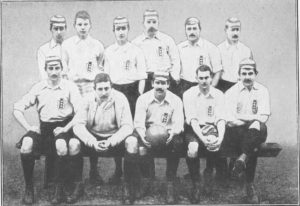
The England side of 1894 v Wales – every player came from Corinthians.
The rain kept the crowd down to around 3,000 people, who watched Everton beat the crack amateur side by three goals to one. The rules of hospitality were then honoured, but it would appear that our journalist friend disagreed with some of the comments that were made during the after-dinner speeches:
It was urged on behalf of the Corinthians, that they were not fully represented and that with ordinary luck and the verdict against of three goals to one – which oddly was turned in to a narrow margin – might have been reversed. This is the old style of minimising a defeat, but of course it is comforting to fall back upon the black-eyed excuse that the absence of this or the other good man naturally effected the issue, for the matter of that Everton were not nearly fully represented – and no mention was made – along with Geary – or the absence of Brady and the Everton skipper – Hannah. Taking everything in to account it will be concluded that Pa Jacksons cracks were beaten on merits and on their own battle ground.
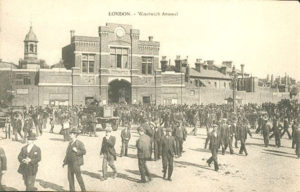
The Everton party, nonetheless continued to enjoy their tour and next day …made the best of their time by sightseeing in the city during the morning, and afterwards driving to Hampton Court. On Monday morning, they headed off to their next destination, where they were greeted on arrival at Woolwich, by the executive of Royal Arsenal Football Club.
 The location was dominated by the government owned Royal Ordnance Factory that employed around 11,000 people and as had been previously arranged, the Everton party were given a two-hour guided tour around the complex before being taken to the location where the game was to be played at Plumstead. The Londoners had just turned professional and imported players from Scotland, in the hope of becoming the first team, from the south of England, to be elected to the Football League. They had just moved into the Invicta Ground that was described as being, spick and span and replete with dressing rooms, terracing and a grandstand.
The location was dominated by the government owned Royal Ordnance Factory that employed around 11,000 people and as had been previously arranged, the Everton party were given a two-hour guided tour around the complex before being taken to the location where the game was to be played at Plumstead. The Londoners had just turned professional and imported players from Scotland, in the hope of becoming the first team, from the south of England, to be elected to the Football League. They had just moved into the Invicta Ground that was described as being, spick and span and replete with dressing rooms, terracing and a grandstand.
All that is left of the Invicta Ground, Arsenal, today; a few terraces in private gardens. The ground was only in use by Woolwich Arsenal between 1890-1894.
The weather had much improved from Saturday and around 8,000 people paid the fee required to enter the enclosure. The Merseyside men proved too strong for their opponents and beat them comfortably by five goals to nil. That evening, the Everton party were spotted watching a show at the Drury Lane Theatre before settling down for the night. Next morning, they boarded a train at Charing Cross Railway Station, that took them back in to the County of Kent to compete in their third and final game of the tour.
 This copy of the game with Royal Arsenal makes one wonder if the outside left of the home side was indeed the 18-year-old budding polymath, C B Fry. Shaw, who appears in the Everton side, was an amateur player with Great Marlow who had been invited to have a trial period with the club while they were in London.
This copy of the game with Royal Arsenal makes one wonder if the outside left of the home side was indeed the 18-year-old budding polymath, C B Fry. Shaw, who appears in the Everton side, was an amateur player with Great Marlow who had been invited to have a trial period with the club while they were in London.
The party alighted at the River Medway town of Chatham, where the Royal Naval dockyard overwhelmed the waterfront while the interior contained an area called the ‘Great Lines of Defence’ that surrounded the regimental headquarters of the Royal Engineers, whose football players, in 1875 had brought the FA Cup home. The Chatham club had begun their football life sharing a pitch inside Great Lines, with their military neighbours, but the land was owned by the government, who prohibited any money being charged to enter their property. This fact had come to light in 1889 when the Chatham amateurs had reached the last eight of the FA Cup and this made the professional clubs complain to football authorities about not getting their share of gate money that was required in order to offset the expense that was incurred travelling to fulfil the fixture.
The Kentish side however, had inspirations similar to that of the Royal Arsenal Club and used the visit of Everton to introduce the new enclosure they had recently constructed on Maidstone Road. The weather was again unfriendly but this did not stop around 5,000 people attending a game that Everton won by four goals one. The result concluded what had been a most successful tour of the capital and the visiting party caught their train back to London and then onwards to Liverpool to prepare for their next Football League game against Bolton Wanderers.


